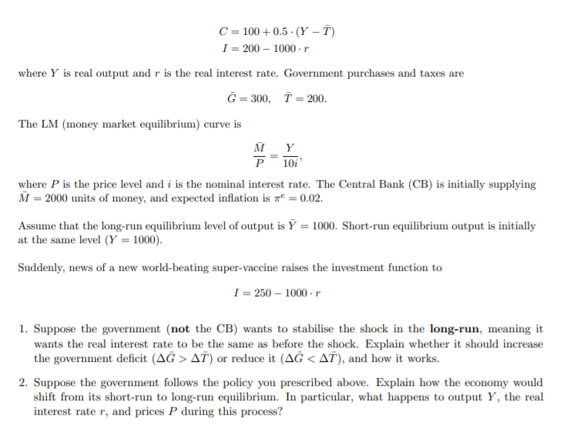C = 100 + 0.5 - (Y – T) I= 200 – 1000 -r where Y is real output and r is the real interest rate. Government purchases and taxes are Ĝ = 300, T = 200. The LM (money market equilibrium) curve is P 101 where P is the price level and i is the nominal interest rate. The Central Bank (CB) is initially supplying M = 2000 units of money, and expected inflation is z“ = 0.02. Assume that the long-run equilibrium level of output is Ÿ = 1000. Short-run equilibrium output is initially at the same level (Y = 1000). Suddenly, news of a new world-beating super-vaccine raises the investment function to I = 250 – 1000 - r 1. Suppose the government (not the CB) wants to stabilise the shock in the long-run, meaning it wants the real interest rate to be the same as before the shock. Explain whether it should increase the government deficit (AĞ > AT) or reduce it (AĞ < AT), and how it works. 2. Suppose the government follows the policy you prescribed above. Explain how the economy would shift from its short-run to long-run equilibrium. In particular, what happens to output Y, the real interest rate r, and prices P during this process?
C = 100 + 0.5 - (Y – T) I= 200 – 1000 -r where Y is real output and r is the real interest rate. Government purchases and taxes are Ĝ = 300, T = 200. The LM (money market equilibrium) curve is P 101 where P is the price level and i is the nominal interest rate. The Central Bank (CB) is initially supplying M = 2000 units of money, and expected inflation is z“ = 0.02. Assume that the long-run equilibrium level of output is Ÿ = 1000. Short-run equilibrium output is initially at the same level (Y = 1000). Suddenly, news of a new world-beating super-vaccine raises the investment function to I = 250 – 1000 - r 1. Suppose the government (not the CB) wants to stabilise the shock in the long-run, meaning it wants the real interest rate to be the same as before the shock. Explain whether it should increase the government deficit (AĞ > AT) or reduce it (AĞ < AT), and how it works. 2. Suppose the government follows the policy you prescribed above. Explain how the economy would shift from its short-run to long-run equilibrium. In particular, what happens to output Y, the real interest rate r, and prices P during this process?
Chapter1: Making Economics Decisions
Section: Chapter Questions
Problem 1QTC
Related questions
Question

Transcribed Image Text:С - 100 + 0.5- (Ү -Т)
I = 200 – 1000 -r
where Y is real output and r is the real interest rate. Government purchases and taxes are
G = 300, T = 200.
The LM (money market equilibrium) curve is
Y
P
10i
where P is the price level and i is the nominal interest rate. The Central Bank (CB) is initially supplying
M = 2000 units of money, and expected inflation is a = 0.02.
Assume that the long-run equilibrium level of output is Ÿ = 1000. Short-run equilibrium output is initially
at the same level (Y = 1000).
Suddenly, news of a new world-beating super-vaccine raises the investment function to
I = 250 – 1000 - r
1. Suppose the government (not the CB) wants to stabilise the shock in the long-run, meaning it
wants the real interest rate to be the same as before the shock. Explain whether it should increase
the government deficit (AĞ > AŤ) or reduce it (AĞ < AT), and how it works.
2. Suppose the government follows the policy you prescribed above. Explain how the economy would
shift from its short-run to long-run equilibrium. In particular, what happens to output Y, the real
interest rate r, and prices P during this process?
Expert Solution
This question has been solved!
Explore an expertly crafted, step-by-step solution for a thorough understanding of key concepts.
Step by step
Solved in 2 steps

Knowledge Booster
Learn more about
Need a deep-dive on the concept behind this application? Look no further. Learn more about this topic, economics and related others by exploring similar questions and additional content below.Recommended textbooks for you


Principles of Economics (12th Edition)
Economics
ISBN:
9780134078779
Author:
Karl E. Case, Ray C. Fair, Sharon E. Oster
Publisher:
PEARSON

Engineering Economy (17th Edition)
Economics
ISBN:
9780134870069
Author:
William G. Sullivan, Elin M. Wicks, C. Patrick Koelling
Publisher:
PEARSON


Principles of Economics (12th Edition)
Economics
ISBN:
9780134078779
Author:
Karl E. Case, Ray C. Fair, Sharon E. Oster
Publisher:
PEARSON

Engineering Economy (17th Edition)
Economics
ISBN:
9780134870069
Author:
William G. Sullivan, Elin M. Wicks, C. Patrick Koelling
Publisher:
PEARSON

Principles of Economics (MindTap Course List)
Economics
ISBN:
9781305585126
Author:
N. Gregory Mankiw
Publisher:
Cengage Learning

Managerial Economics: A Problem Solving Approach
Economics
ISBN:
9781337106665
Author:
Luke M. Froeb, Brian T. McCann, Michael R. Ward, Mike Shor
Publisher:
Cengage Learning

Managerial Economics & Business Strategy (Mcgraw-…
Economics
ISBN:
9781259290619
Author:
Michael Baye, Jeff Prince
Publisher:
McGraw-Hill Education